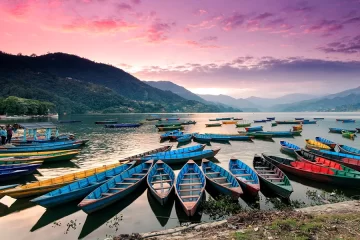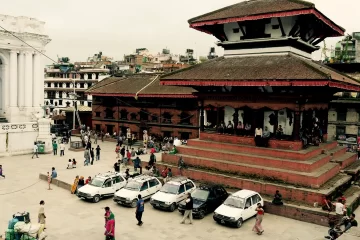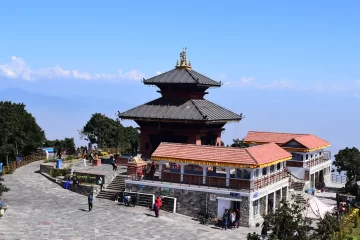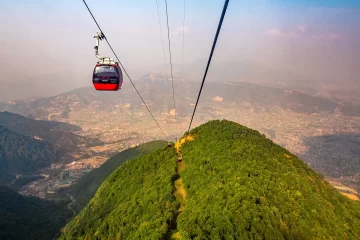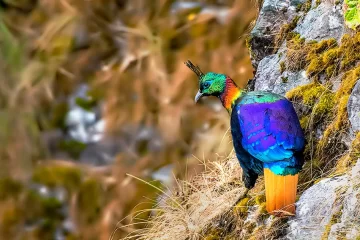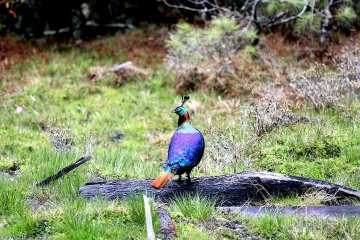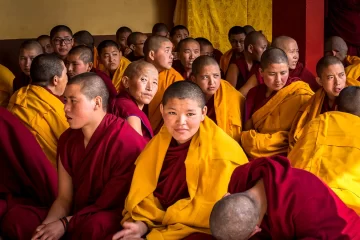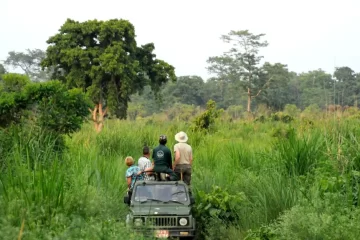11 Must Visit Monastery and Buddhist Temples in Nepal for Spiritual Enlightenment
Nepal, nestled in the majestic Himalayas, captivates with its breathtaking landscapes. It has a rich culture and a solid connection to Hinduism and Buddhism.
Nepal is full of lively traditions. It has meaningful ceremonies and remarkable landmarks that hold spiritual importance.
Monasteries and Buddhist temples in Nepal are revered as religious treasures. They represent wisdom, peace, and enlightenment.
Join us on a unique journey as we explore the spiritual heart of Nepal, In this article. We will reveal Nepal’s top 10 Buddhist temples and monasteries, representing spiritual heritage.
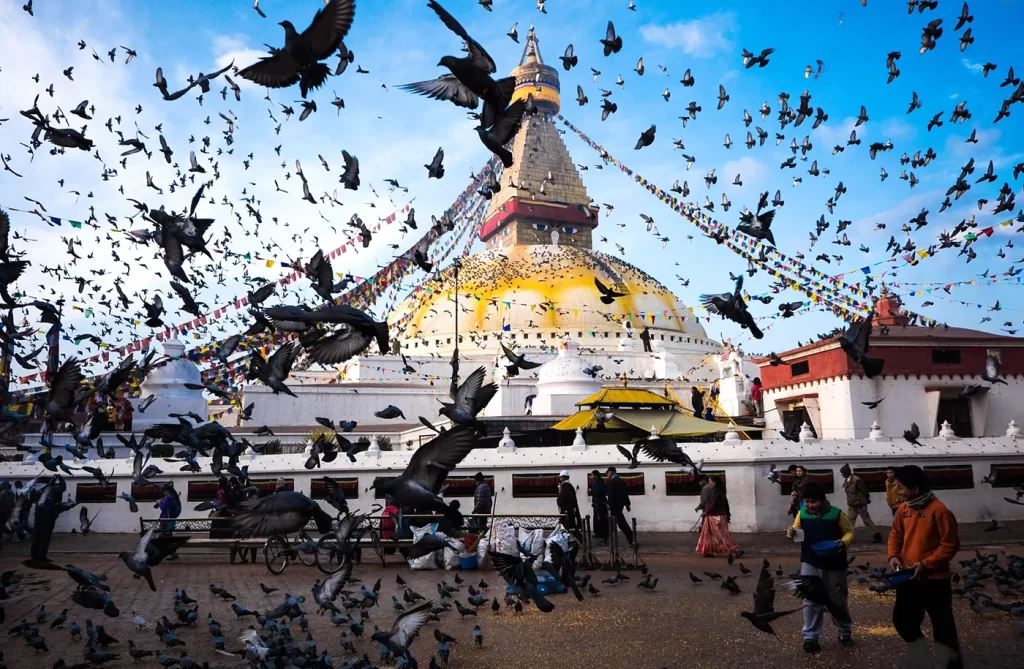
A brief history of Buddhism in Nepal
Buddhism has a long history in Nepal and is an important part of Nepalese culture. Nepal is a favored destination for spiritual seekers as over 10% practice Buddhism.
Nepal’s Buddhist temples go beyond religious significance. They represent the country’s cultural heritage and history.
Buddhism entered Nepal in the 3rd century BCE during the reign of Emperor Ashoka. He played a big role in making Buddhism well-known throughout his empire.
Gautama Buddha was born in Lumbini, Nepal. His birth is significant in Buddhism’s history. It marks the start of his path to enlightenment.
People have been building Buddhist monasteries, temples, and sacred places all over Nepal for many years. They became essential parts of Nepal’s culture and religion.
Nepal attracts Buddhist scholars and seekers from neighboring countries. They go to famous monastic centers to involve in spiritual activities.
Even today, Buddhism holds great significance in Nepalese culture. Buddhist temples and monasteries are crucial for religious and spiritual practices.
Importance of Monasteries & Buddhist Temples in Nepalese Culture
Monastery and Buddhist temples in Nepal have great importance in the country’s culture and history. It holds a special place in people’s hearts. Buddhist Temples serve as sacred spaces for inner peace and reflection.
The architecture of Nepalese temples reflects the country’s rich cultural heritage. Communities gather at temples for religious ceremonies and celebrations in Nepal.
Pilgrims from around the world visit Nepalese Buddhist temples seeking enlightenment and blessings. Buddhist temples in Nepal are like special places. They offer peace and comfort to people. People go there to think, find peace, and feel spiritually fulfilled.
Nepalese Buddhist temples and monasteries follow the teachings of Buddhism. They promote kindness, awareness, and peace. It helps the Nepalese on their spiritual paths as well.
During festivals and special occasions, the temples hold even greater significance. People from all backgrounds come together to show respect and offer prayers at these times.
11 Best Monasteries / Buddhist Temples in Nepal
1. Boudhanath Stupa
The Boudhanath Stupa, located in Kathmandu, is one of the largest stupas in the world. It’s believed to date back to the 14th century and is a UNESCO World Heritage Site.
This sacred site attracts many visitors who come to offer prayers and pay their respects. It is a significant place of worship and devotion for Buddhists in Nepal. The stupa carries a rich history and serves as a symbol of spiritual significance in the region.
Buddhist monks and nuns perform daily rituals and practices at the stupa. Also, the visitors can observe them circling the stupa and meditating.
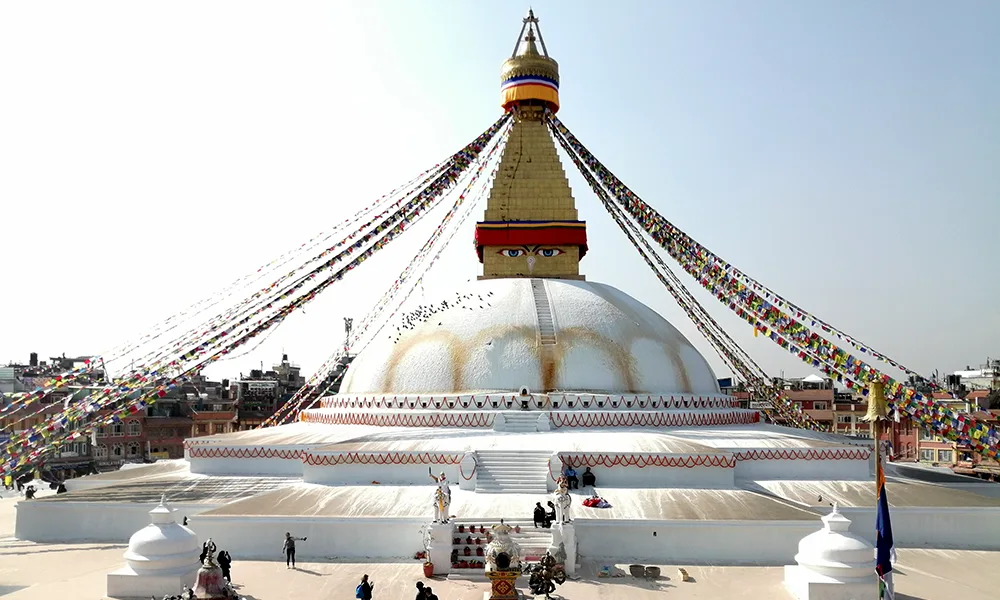
History
After the Mughal invasion of Kathmandu in the late 14th century, people believed they constructed the stupa. Furthermore, it is believed that the stupa contains the remains of Kassapa Buddha.
Over the centuries, Boudhanath Stupa has been an important center of spiritual devotion and pilgrimage. It has attracted Buddhist practitioners, scholars, and followers from all over the world.
Boudhanath Stupa’s construction was initiated by a Nepalese king inspired by Swayambhunath Stupa. Boudhanath Stupa received UNESCO World Heritage Site status in 1979 for its cultural and historical value.
Throughout its history, Boudhanath Stupa has undergone several renovations and reconstructions.
Architecture and Design
The architecture of Boudhanath Stupa combines Nepalese and Tibetan styles. It has a large dome shape and is adorned with whitewashed bricks and colorful prayer flags. It’s also decorated with intricate mandalas and other Buddhist artwork. It stands as a significant symbol of Buddhist culture and faith.
The entire design of the stupa captivates the attention of visitors. The all-seeing painted eyes, called “the eyes of Buddha,” symbolize awareness and enlightenment.
The design of Boudhanath Stupa is a testament to the devotion and reverence of the Nepalese people.
2. Swayambhunath
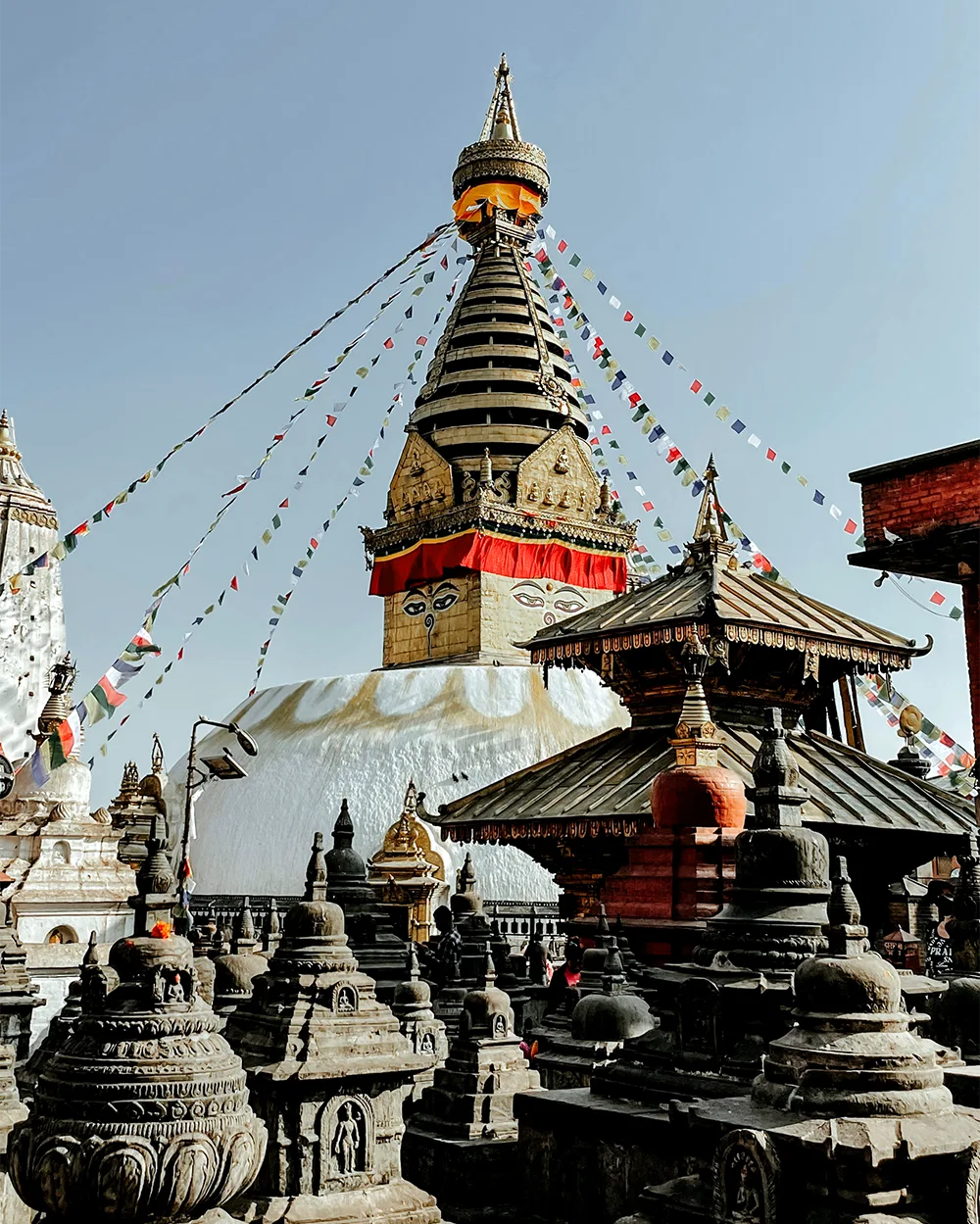
Swayambhunath is the oldest and one of Nepal’s most famous Buddhist temples. It is located on a hilltop in Kathmandu and offers stunning city views.
The temple is very popular as the Monkey Temple among tourists worldwide. The temple is home to many monkeys who have become a distinct character component of the site.
Swayambhunath is a popular destination for spiritual and cultural tourism in Nepal. The blend of history, culture, and natural beauty makes Swayambhunath a must-see destination.
Visitors have the opportunity to join monks in meditation sessions at Swyambhunath. They can actively take part in spiritual practices like prayer and lighting incense.
Swyambhunath, the most popular Buddhist temple in Nepal, provides a serene environment. It serves as a haven for individuals seeking spiritual experiences and introspection.
History
The Swyambhunath temple is one of Nepal’s oldest and most significant Buddhist sites. People believe it was constructed more than 2,000 years ago.
According to the legend, it was built by a mythical creature called Padmasambhava. Padmasambhava is also known as the lotus-born. The construction of the stupa is attributed to him in the folklore.
Over time, the site has undergone numerous changes and transformations. Also, new buildings have been added to the site. Along with new structures, various statues have also been installed at Swyambhunath.
It has endured earthquakes, invasions, and other challenges, preserving its spiritual significance. Today, it stands as a symbol of peace, enlightenment, and spiritual heritage.
Ancient Swayambhunath Stupa earned UNESCO Heritage Site status in 1979.
Design & Architecture
Swayambhunath’s design and architecture blend artistic and architectural styles. The grand stupa is the main highlight, adorned with intricate carvings. Its elegant design reflects the cultural influences and craftsmanship of Nepal.
Exquisite carvings and intricate decorative elements adorn the stupa. The stupa’s unique shape is a captivating focal point of Swayambhunath’s architecture. Its distinct design stands out amidst the surrounding structures.
Various temples, shrines, and monastic buildings surround Swayambhunath. These structures exhibit a mix of architectural influences from Nepal, Tibet, and the Newar culture.
3. Kopan Monastery

Kopan Monastery is a beautiful and serene Buddhist monastery in Nepal. Established in 1969, the monastery is atop a hill, providing a panoramic view of the Kathmandu Valley.
Kopan Monastery lies 6 km from the heart of Kathmandu, accessible within a 30-minute drive. It offers a peaceful retreat not far from the bustling city.
The monastery has become a significant spiritual and cultural destination, drawing visitors worldwide.
The monastery is famous for its peaceful and vibrant atmosphere. The monastery spreads the teachings of Buddhism through retreats, meditation, and educational programs. Read More
History
Kopan Monastery was founded in the 1970s by Lama Yeshe and Lama Zopa Rinpoche. Initially, it served as a residence for the Lamas and a place for solitary retreats.
Later, Kopan Monastery became a thriving center for Buddhist teachings and practices.
Design & Environment
The main designs of the Monastery feature vibrant colors and intricate decorative elements. The buildings are adorned with ornate carvings, colorful paintings, and elaborate murals.
The walls and interior of the Monastery have beautiful paintings and artwork. These paintings and artwork make the feeling of the place more spiritual. People who visit the Monastery can enjoy looking at the detailed artwork.
Furthermore, The Monastery offers stunning views of the mountains and verdant hillsides. The spectacular scenery makes it an ideal retreat place for peaceful environment seekers.
4. Lumbini

Lumbini is another popular place for Monasteries and Buddhist temples in Nepal. It is the most famous spiritual place in the world. It holds the recognition as the birthplace of Gautam Buddha.
Lumbini is situated in the south western region of Nepal. Lumbini is approximately 276 kilometers (171 miles) from the capital, Kathmandu. The journey by road takes around 7 hours, while a flight can cover the distance in 30 minutes.
Lumbini holds great historical and religious significance as the birthplace of the Buddha. The site contains archaeological remains, including temples, monasteries, and a palace.
It is a UNESCO World Heritage Site (1997) that attracts Buddhist pilgrims and tourists worldwide.
Today, Lumbini is one of the world’s significant pilgrimage sites, attracting millions of visitors.
History
Lumbini has long and fascinating history dates back to the 6th century BC.
Queen Maya Devi (mother of the Buddha) gave birth to Buddha in Lumbini. The birth took place during her journey from the palace in Kapilavatthu.
The exact birth date of Siddhartha Gautama is unknown. Yet, it is generally believed to have happened around the 6th century BCE.
Emperor Ashoka, a devout Buddhist, visited Lumbini in the 3rd century BCE. As a mark of reverence, Ashoka erected commemorative pillars in Lumbini. These pillars were meant to signify and honor the birthplace of the Buddha.
The inscriptions on the pillars played a vital role in identifying Lumbini as the sacred site of Buddha’s birth.
Over time, people constructed several monasteries and temples in Lumbini. In 1997, Lumbini received the prestigious UNESCO World Heritage Site designation. It has played a significant role in the preservation and protection of Lumbini.
Monasteries and Temples in Lumbini, Nepal
Lumbini has several monasteries and temples, each representing various Buddhist traditions and countries. Here are a few examples of the monasteries and temples you can explore in Lumbini. Each of them represents a unique cultural and religious tradition.
- Maya Devi Temple
- Mahabodhi Temple
- Thai Monastery
- Chinese Monastery
- Korean Monastery
- Myanmar Golden Temple
- Vietnam Phat Quoc Tu Temple
5. Namobuddha Monastery

Namobuddha Monastery, or Thrangu Tashi Yangtse Monastery, is a sacred Buddhist site in Nepal. It is another famous monastery in Nepal situated in a remote village. The site is located 42 kilometers southeast side of Kathmandu Valley.
The Monastery is ideal for spiritual practice. It is highly revered in the Buddhist tradition. Also, It provides a peaceful and serene environment.
The site attracts both local devotees and international tourists. It offers an opportunity to experience tranquility and solitude in its serene surroundings.
Namobuddha Monastery serves as a center for Buddhist education. It provides the opportunity to study Buddhist philosophy. It also offers the chance to practice meditation and mindfulness.
How to reach
Namo Buddha is approximately 42km away from the Kathmandu city. There are three options to reach Namo Buddha Monastery: hiking, bus, and taxi.
Walking is the preferred method for those who enjoy hiking to reach Namo Buddha Monastery. Taking a bus is another option for reaching the Monastery. Hiring a taxi is recommended for getting to Namo Buddha Monastery. Choosing a taxi saves considerable time compared to other transportation options.
Normally, people begin their hike from Dhulikhel to reach Namo Buddha. The journey takes approximately 4 hours to reach the site. But it depends on several factors, such as individual fitness level and the chosen route.
Traveling by local bus to Namo Buddha takes 3 to 4 hours due to the many substations. A taxi ride from Kathmandu to Namo Buddha usually takes about 2 hours.
6. Pharping Monastery

Pharping Monastery is located in the serene hills of Nepal. The Monastery is situated approx 20 kilometers southwest of Kathmandu Valley.
It is a sacred haven for Buddhist and spiritual enlightenment seekers. Here, visitors can engage in meditation, contemplation, and religious devotion. The Monastery offers a tranquil retreat from city life.
Pharping is the home to several Tibetan Buddhist monasteries and retreat centers. The centers provide opportunities for spiritual practice and immersion in Tibetan Buddhist traditions.
The area offers many temples and monasteries for visitors to explore. Among the sites, the Asura Cave, Yangshuo Cave, and Vajra Yogini Temple are the most famous.
History
Pharping Monastery has a long and rich history dating back centuries.
According to legend, a nearby cave is associated with the renowned saint Padmasambhava. It is believed that Padmasambhava chose this Cave as a place of meditation.
The Cave, known as Asura Cave, holds spiritual significance. Many pilgrims visit the Cave in Pharping, a favorite attraction of this area.
7. Tengboche Monastery
The auspicious Tengboche Monastery is in the beautiful village of Tengboche, where the Monastery gets its name from. It has great importance among the Sherpas and many other Buddhist communities. Also, it is one of the most famous monasteries in Nepal.
The place lies on the pathway to Everest and hence attracts a lot of tourists all year round. Trek to this Monastery takes about three days after landing at the Lukla airport.
Because the Monastery lies at a high altitude, it is a great viewpoint of famous mountains like Everest, Lhotse, Nuptse, and many others.

History:
The Monastery was built in the year 1916. The Monastery lies in the eastern region of Nepal called Khumbu.
The Monastery’s history goes back to when Lama Sangwa Dorje expressed his idea of building a monastery in this village.
However, his wish was fulfilled by his fifth incarnation Lama Guru. Tenzin Norbu, who was among the first men to climb Everest, was a monk here. Hence many climbers come to this Monastery to seek blessing for a successful climb to the summit. So it holds special importance for all adventure lovers among other Buddhist temples in Nepal.
Architecture:
The Monastery’s beams, walls, and columns use stone masonry construction that uses different shaped stones for construction. The stones, along with mortar, help to keep the structure intact together.
The Monastery is very well-built and is among the oldest monasteries in the country. The Monastery is based on the concept of Tibetan architecture, and its history goes back to Tibet.
8. Maratika Monastery
The Maratika Monastery is in the Halesi village. This village lies in Okhaldunga, a town in the Khotang district. This Monastery is in the Maratika caves, part of the Mahabharat range.
It is believed among the Buddhists that this is where Guru Padmasambhava gained immortal life. In 2011, the place lost its holy Guru, Trulshik Rinpoche, who was also the Guru of his holiness.

Maratika Monastery lies between two beautiful rivers, Dudh Koshi and Sun Koshi. The place is equally holy for both Buddhists and Hindus.
It is considered that one of the disciples of Buddha Amitayus hid the teachings of eighteen tantras of life here in the Maratika cave.
Guru Padmasambhava later received it, and hence he achieved immortal life. The Guru then proceeded to Tibet to expand his teachings.
Currently, the Monastery is also a place for young monks to gain religious knowledge. Despite the difficulties during the pandemic, the monks lived here and shared their knowledge.
9. Shechen Monastery (Kathmandu)
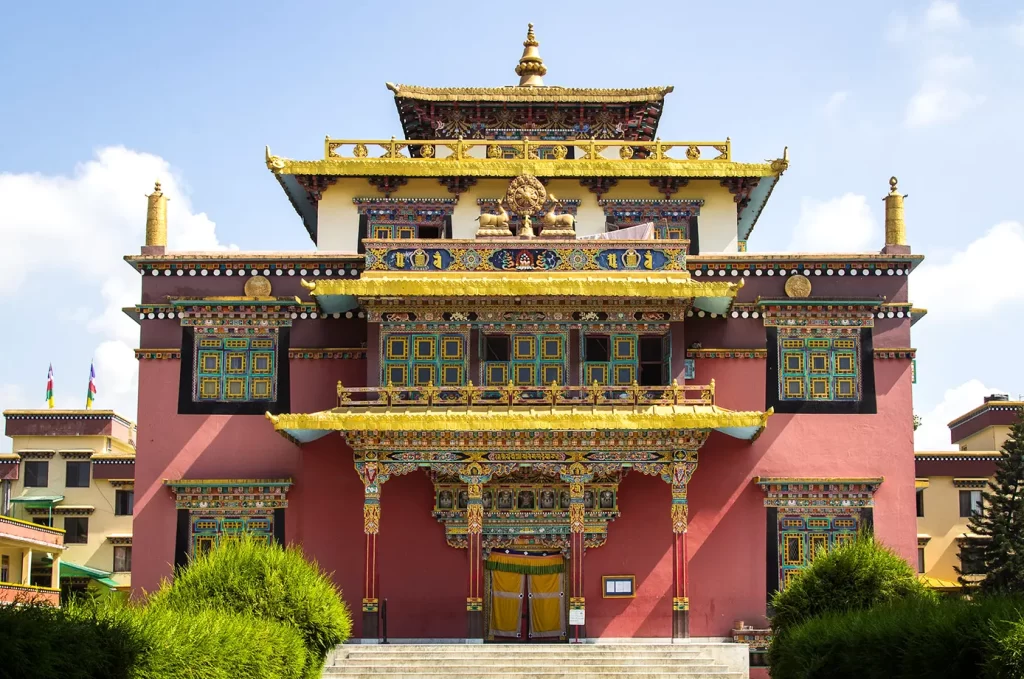
The Shechen Monastery is situated in Boudhanath, Kathmandu, Nepal. Building this magnificent Monastery representing the Tibetan Buddhist culture took over ten years.
The Monastery faced many problems due to natural disasters and traditional riots. Despite all the issues it faced, the Monastery stands tall and powerful. It is all due to the blessings of lord Buddha and the strong will of the followers.
This Monastery is a Nyingma category, one of Tibet’s six main Monasteries. The Monastery very well demonstrates Buddhism’s traditional, artistic, and disciplinary aspects.
The place is one of the best examples of Tibetan art. After all, it took the best craftsman, designers, goldsmiths, and fine artists to build the Monastery in Kathmandu.
History
The history of the Monastery goes back to Tibet, where the Shechen Monastery was located years ago. But, it was destroyed in Tibet due to the government’s revolution policy.
Guru Dilgo Khyentse Rinpoche, a renowned Buddhist teacher, envisioned rebuilding the Monastery in Nepal. It is because Nepal has a rich Buddhist community, and many people follow Buddhism.
The Monastery found an ideal location for its existence. Believers were blessed with a beautifully constructed and traditionally attractive place. The Monastery was built after ten years of financial and design work.
10. Thubchen Lhakang Monastery
This Monastery in the upper Mustang region of Nepal has the most fantastic art and architecture. The art was done on the walls of this Monastery in the 15th century.
The paintings consist of beautiful Buddha portraits, both big and small. It has the dharma chakra painted in. A way that it depicts Buddha’s teachings and practices.
The main building block of the place is wood, clay, and stonework. The main entrance door consists of six carved lion heads and script writings.

History
Thubchen Lhakang Monastery was constructed in the 15th century. It is one of the oldest monasteries and Buddhist temples in Nepal.
The place has stood strong in all the major earthquakes in Nepal. The wall painting has worn out many times but has been restored.
The paintings were first restored by Padma Bhuti in 1815 and the second during King Magendra’s rule in 1998.
11. White Gumba/Monastery (Seto Gumba)
The White Monastery, also known as Seto Gumba or gompa in Nepali. It is one of the most easily reachable monasteries in the capital city. The Monastery is very famous among the locals as well as foreign visitors.
It is located outside the ring road on the way to the Swoyambhunath Stupa, another famous Buddhist temple in Nepal.
The architecture of the Monastery brings its root from Tibet. As the name suggests, the Monastery is white; hence, carvings and colorful paintings are highlighted more. The palace reflects peace and calmness in between the chaos of the city.

Views from Monastery
The view of Kathmandu Valley from the Monastery is spectacular. This is the reason people from different religions visit here. One can also hike to this place or ride a bike. Many come here as a hiking destination.
The place is on Druk Amitabh Mountain, and the high altitude gives a perfect sunrise and sunset view from the Monastery.
The surroundings of the Monastery are expansive. Paintings, small monasteries, green terrains, and other elements beautifully depict Buddhist culture.
